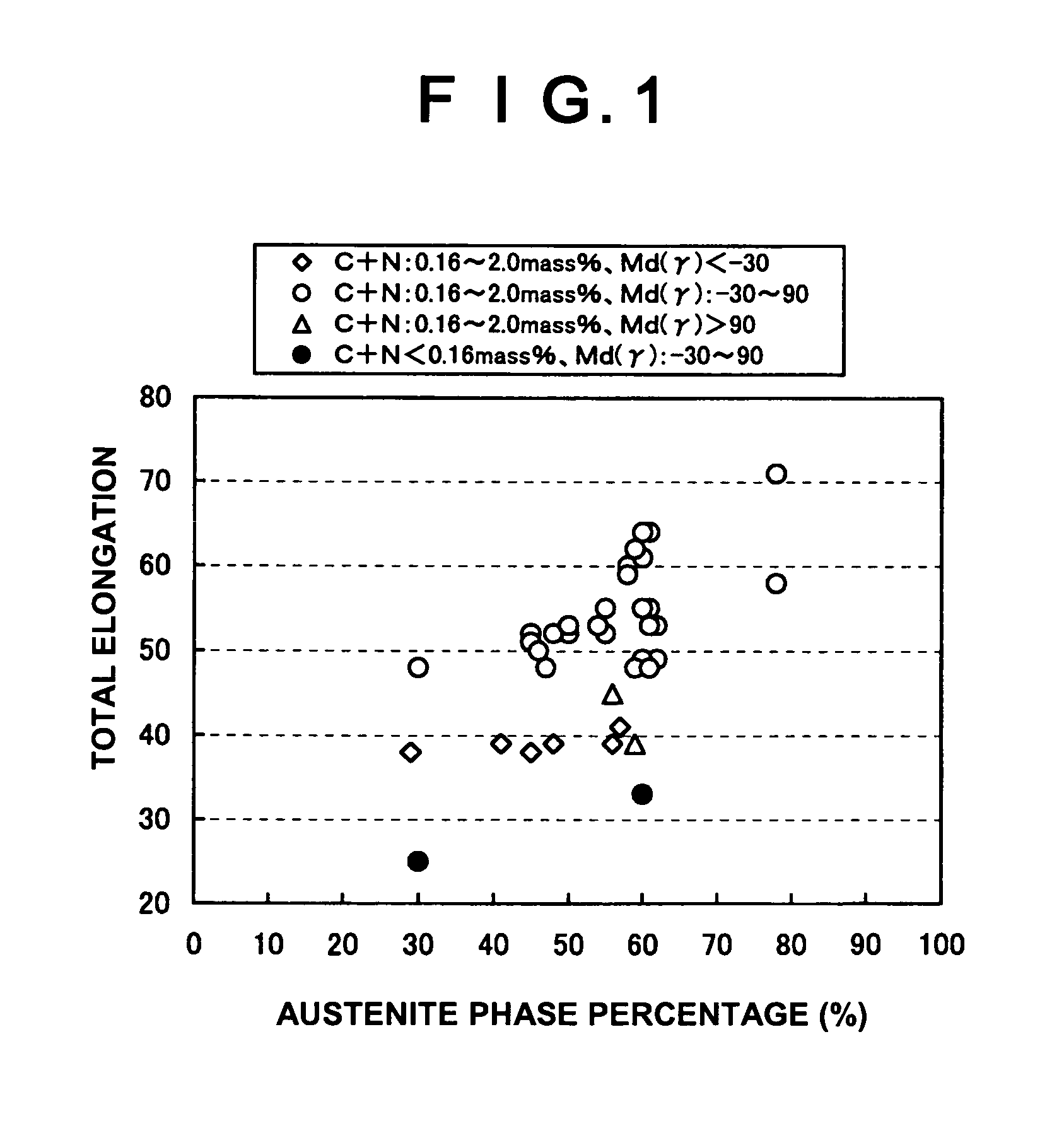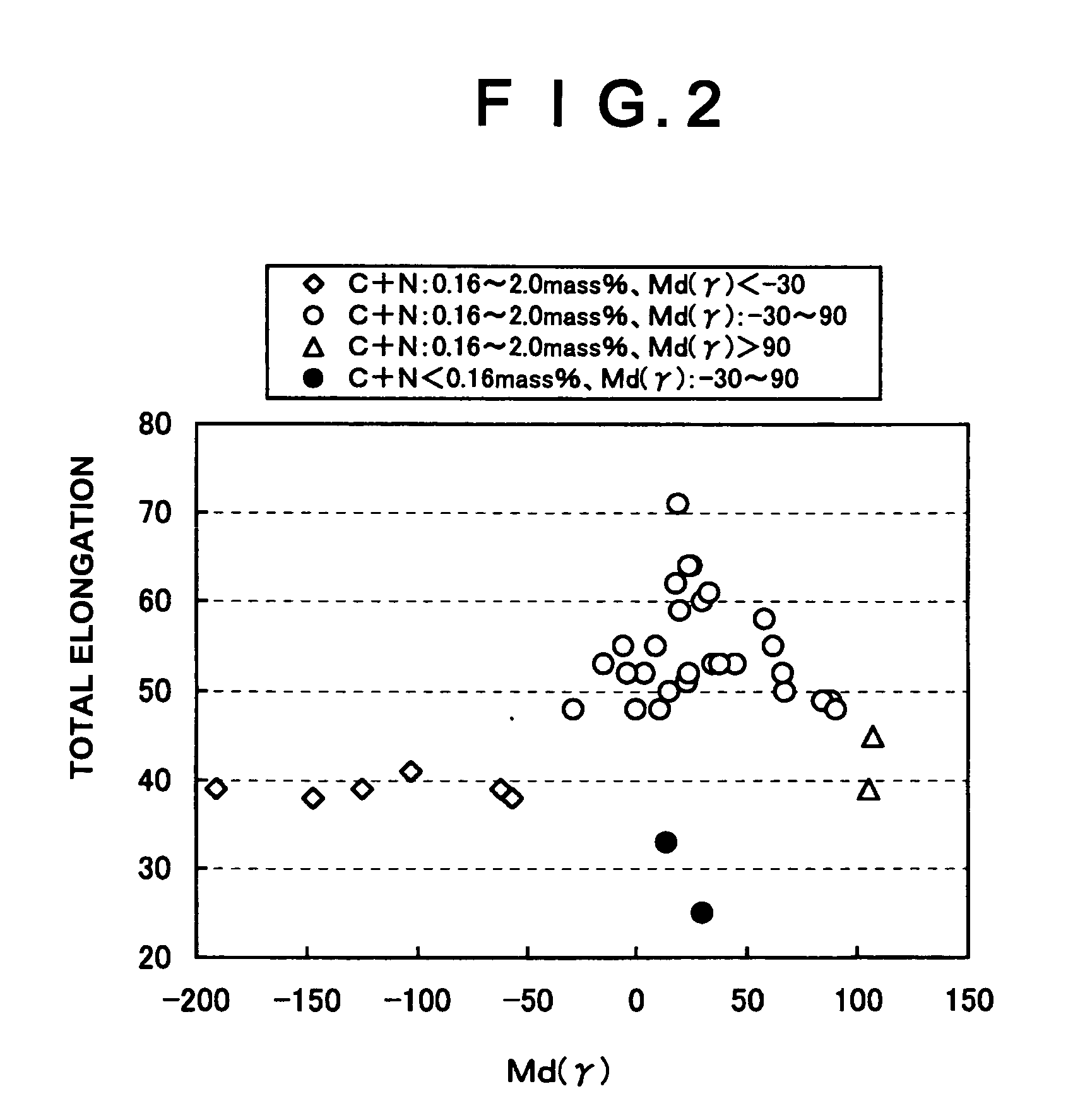Austenitic-ferritic stainless steel
a technology of stainless steel and ferric acid, applied in the field can solve the problems of high workability of steels, high cost of austenitic stainless steels, and high cost of austenitic stainless steels, and achieve excellent ductility, deep drawability, and high formability.
- Summary
- Abstract
- Description
- Claims
- Application Information
AI Technical Summary
Benefits of technology
Problems solved by technology
Method used
Image
Examples
example 1
[0117] Steels having various compositions given in Table 1 were ingoted by vacuum melting or in an atmosphere with 0 to 1 atm of nitrogen partial pressure to prepare the respective steel slabs. The slabs were heated to 1250° C., and were treated by hot-rolling (11 to 12 passes to hot-roll to 3 to 4 mm in thicknesses), annealing the hot-rolled sheets (1100° C. for 1 minute), and cold-rolling (cold-rolled at the Temperature from room temperature to 300° C.). After that, the sheets were treated by finish-annealing at the respective annealing temperatures given in Table 2, for 1 minute, thus obtained the respective cold-rolled and annealed sheets having 0.8 mm in thickness, while having different percentage of austenite phase and different amount of (C+N) in the austenite phase from each other.
[0118] Thus obtained cold-rolled and annealed sheets underwent the structure observation, composition analysis of austenite phase, tensile test, and determination of limited drawing ratio (LDR) a...
example 2
[0128] Steels having various compositions given in Table 3 were ingoted by vacuum melting or in an atmosphere with controlled nitrogen partial pressures to prepare the respective steel slabs. The slabs were heated to 1250° C., and were treated by hot-rolling (11 to 12 passes to hot-roll to 3 to 4 mm in thicknesses), annealing the hot-rolled sheets (1100° C. for 1 minute), and cold-rolling (cold-rolled at the temperature from room temperature to 300° C.). After that, the sheets were treated by finish-annealing at temperatures ranging from 950° C. to 1300° C. given in Table 4, for 30 to 600 seconds under an atmosphere of controlled nitrogen partial pressure, thus obtained the respective cold-rolled and annealed sheets having 1.25 mm in thickness, while having different percentages of austenite phase and different amounts of (C+N) in the austenite phase from each other. Thus obtained cold-rolled and annealed sheets underwent the structure observation, the analysis of C and N in the aus...
example 3
[0148] Steels having various compositions given in Table 5 were ingoted by vacuum melting or in an atmosphere with controlled nitrogen partial pressures up to 0.9 atm (882 hPa) to prepare the respective steel slabs (or ingots or casts). The slabs were heated to 1250° C., and were treated by hot-rolling (11 to 12 passes to hot-roll to 3 to 4 mm in thicknesses), annealing the hot-rolled sheets (1100° C. for 1 minute), and cold-rolling (cold-rolled at the temperature from room temperature to 300° C.). After that, the sheets were treated by finish-annealing at temperatures ranging from 900° C. to 1300° C., thus obtained the respective cold-rolled and annealed sheets having 1.25 mm in thickness. The obtained cold-rolled and annealed sheets underwent the determination of percentage of austenite phase, punch stretchability, and crevice corrosion resistance.
[0149] Determination of the percentage of austenite phase was conducted by similar procedure with that for Example 1. The punch stretc...
PUM
| Property | Measurement | Unit |
|---|---|---|
| total elongation | aaaaa | aaaaa |
| tensile elongation | aaaaa | aaaaa |
| tensile elongation | aaaaa | aaaaa |
Abstract
Description
Claims
Application Information
 Login to View More
Login to View More - R&D
- Intellectual Property
- Life Sciences
- Materials
- Tech Scout
- Unparalleled Data Quality
- Higher Quality Content
- 60% Fewer Hallucinations
Browse by: Latest US Patents, China's latest patents, Technical Efficacy Thesaurus, Application Domain, Technology Topic, Popular Technical Reports.
© 2025 PatSnap. All rights reserved.Legal|Privacy policy|Modern Slavery Act Transparency Statement|Sitemap|About US| Contact US: help@patsnap.com



